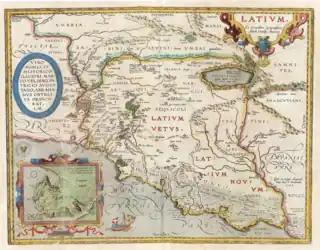Aequian language
Aequian is an extinct Italic language presumed spoken by the people the Romans termed Aequi and Aequicoli living in the Alban hills of northeast Latium and the central Apennines east of them during the early and middle Roman Republic; that is, approximately from the 5th to the 3rd century BC, when they were defeated by the armies of Rome and were subsequently Romanized. As the area was heavily colonized by Latin speakers from Rome, most of the inscriptions from there are in Latin. Two undated inscriptions appear to be in a different dialect, termed Aequian by the scholars with the presumption that in fact they represent the language of the entire pre-Roman tribe. Not enough text survives to deduce any more than that it belonged to the Italic branch of the Indo-European language family.
| Aequian | |
|---|---|
| Native to | Aequian country |
| Region | Latium, east-central Italy |
| Era | attested 5th to 3rd century BC[1] |
Indo-European
| |
| Language codes | |
| ISO 639-3 | xae |
xae | |
| Glottolog | aequ1239aequ1238 code retired |
 Abraham Ortelius's map of ancient Latium, published in 1595 | |
Corpus
Aequian is scantily documented by two inscriptions. Conway's publication of Italic inscriptions adds a gloss, several place names and several dozen personal names, but it does not distinguish which of these are certainly endonyms and which are Latin exonyms in use by the Latin-speaking population.[2] It is possible that they would have been the same in both cases, but such a hypothesis remains unproven.
The Inscription of Alba Fucens is a bronze plate inscribed with ALBSI PATRE.[3] Conway reconstructs the first word as *albe(n)si, a dative case. Baldi translates the text into Latin as Albano patri, two datives, and into English as "To the (god named) Alban Father."[4]
The second document is the Inscription of Cliternia (Capradosso) in Petrella Salto, an inscribed stone in a spring dissociated from context by nature (it rolled down a hill).[5] The text is:[2]
- VIA INFERIOR | PRIVATAST | T VMBRENI C F |
- PRECARIO | ITVR | PECVS PLOSTRV | NIQVIS AGAT
which is a notice stating that the road is private, passage by permission of Titus Umbrenus, son of Gaius, but beasts of burden are forbidden.
Notes
- Aequian at MultiTree on the Linguist List
- Conway, Robert Seymour (1897). The Italic Dialects. Cambridge: Cambridge University Press. pp. 301–305.
- Ernout 1916, pp. 43–44 gives the CIL number, as the inscription was originally taken to be early Latin: CIL I2 385, VI 3672, IX 4177.
- Baldi, Philip (2002). The Foundations of Latin. Trends in Linguistics: Studies and Monographs. Berlin: Mouton de Gruyter. p. 122.
- CIL IX, 4171, according to Ernout 1916, p. 45.
Bibliography
- Ernout, Alfred (2009) [1916]. Recueil de Textes Latins Archaïques (in French). Internet Archive.